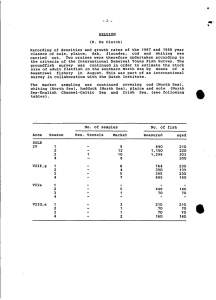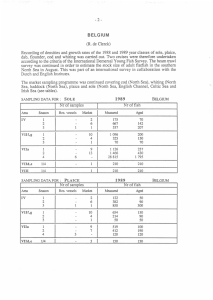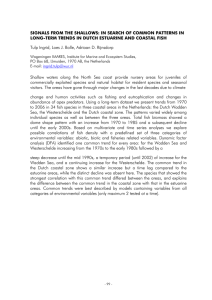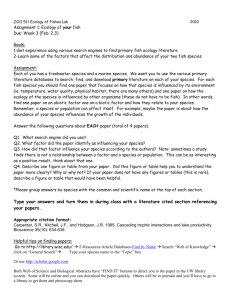Long-term fluctuations in fish recruit abundance in the western
advertisement
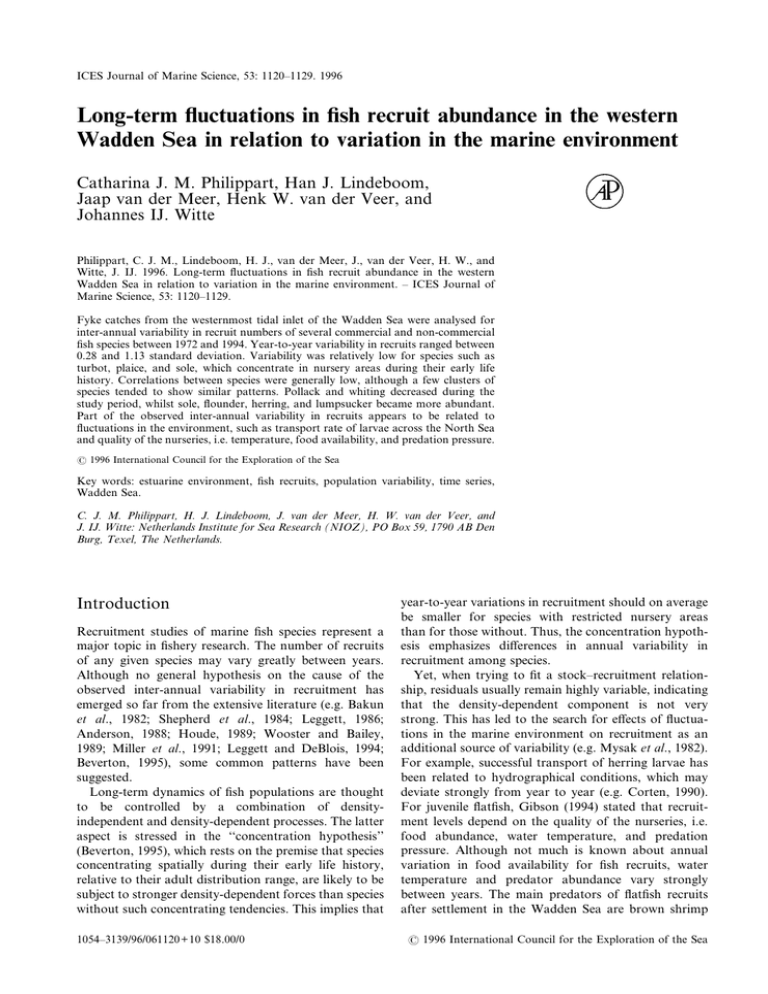
ICES Journal of Marine Science, 53: 1120–1129. 1996 Long-term fluctuations in fish recruit abundance in the western Wadden Sea in relation to variation in the marine environment Catharina J. M. Philippart, Han J. Lindeboom, Jaap van der Meer, Henk W. van der Veer, and Johannes IJ. Witte Philippart, C. J. M., Lindeboom, H. J., van der Meer, J., van der Veer, H. W., and Witte, J. IJ. 1996. Long-term fluctuations in fish recruit abundance in the western Wadden Sea in relation to variation in the marine environment. – ICES Journal of Marine Science, 53: 1120–1129. Fyke catches from the westernmost tidal inlet of the Wadden Sea were analysed for inter-annual variability in recruit numbers of several commercial and non-commercial fish species between 1972 and 1994. Year-to-year variability in recruits ranged between 0.28 and 1.13 standard deviation. Variability was relatively low for species such as turbot, plaice, and sole, which concentrate in nursery areas during their early life history. Correlations between species were generally low, although a few clusters of species tended to show similar patterns. Pollack and whiting decreased during the study period, whilst sole, flounder, herring, and lumpsucker became more abundant. Part of the observed inter-annual variability in recruits appears to be related to fluctuations in the environment, such as transport rate of larvae across the North Sea and quality of the nurseries, i.e. temperature, food availability, and predation pressure. ? 1996 International Council for the Exploration of the Sea Key words: estuarine environment, fish recruits, population variability, time series, Wadden Sea. C. J. M. Philippart, H. J. Lindeboom, J. van der Meer, H. W. van der Veer, and J. IJ. Witte: Netherlands Institute for Sea Research (NIOZ), PO Box 59, 1790 AB Den Burg, Texel, The Netherlands. Introduction Recruitment studies of marine fish species represent a major topic in fishery research. The number of recruits of any given species may vary greatly between years. Although no general hypothesis on the cause of the observed inter-annual variability in recruitment has emerged so far from the extensive literature (e.g. Bakun et al., 1982; Shepherd et al., 1984; Leggett, 1986; Anderson, 1988; Houde, 1989; Wooster and Bailey, 1989; Miller et al., 1991; Leggett and DeBlois, 1994; Beverton, 1995), some common patterns have been suggested. Long-term dynamics of fish populations are thought to be controlled by a combination of densityindependent and density-dependent processes. The latter aspect is stressed in the ‘‘concentration hypothesis’’ (Beverton, 1995), which rests on the premise that species concentrating spatially during their early life history, relative to their adult distribution range, are likely to be subject to stronger density-dependent forces than species without such concentrating tendencies. This implies that 1054–3139/96/061120+10 $18.00/0 year-to-year variations in recruitment should on average be smaller for species with restricted nursery areas than for those without. Thus, the concentration hypothesis emphasizes differences in annual variability in recruitment among species. Yet, when trying to fit a stock–recruitment relationship, residuals usually remain highly variable, indicating that the density-dependent component is not very strong. This has led to the search for effects of fluctuations in the marine environment on recruitment as an additional source of variability (e.g. Mysak et al., 1982). For example, successful transport of herring larvae has been related to hydrographical conditions, which may deviate strongly from year to year (e.g. Corten, 1990). For juvenile flatfish, Gibson (1994) stated that recruitment levels depend on the quality of the nurseries, i.e. food abundance, water temperature, and predation pressure. Although not much is known about annual variation in food availability for fish recruits, water temperature and predator abundance vary strongly between years. The main predators of flatfish recruits after settlement in the Wadden Sea are brown shrimp ? 1996 International Council for the Exploration of the Sea Fish recruit abundance in the Wadden Sea and crabs (van der Veer and Bergman, 1987; van der Veer et al., 1990, 1991), which are rare on the tidal flats after severe winters (Beukema, 1991b) as a result of either increased mortality or migration to deeper waters (Pihl, 1989). In this article, long-term variability in recruit abundance of various fish species in the Dutch Wadden Sea is analysed. The Wadden Sea accommodates large numbers of fish species which use the area primarily during their early life stages. A long-term sampling programme was started in the early 1960s in the Marsdiep, the westernmost and largest tidal inlet between the North Sea and the Wadden Sea (Fig. 1). A kom-fyke trap has been employed at the same location for almost 35 years. Most investigations on fish abundance are restricted to commercially exploited species. However, the fyke catches have resulted in time series of both commercial and non-commercial fish species. Time series of recruit (0-group) abundance in the Marsdiep are (1) compared for differences in year-to-year variability among species, (2) analysed for the existence of covariability between species as an indication that recruit numbers may be related to common environmental factors, and (3) examined for relationships with environmental variables, i.e. North Sea circulation, water temperature, productivity, and predation pressure in the Dutch coastal zone. Material and methods Fyke catches The kom-fyke has been in operation between April and October from 1960 until the present day, being emptied almost every morning from Monday to Friday. Catches are sorted immediately and identified to species level. For the present analysis, only samples were selected which relate to fishing periods of approximately 1 day (24&12 h), since longer periods may have resulted in losses due to decay or consumption by crustaceans. A selection was made for those species for which (1) the assumption seemed reasonable that a constant fraction of the western Wadden Sea populations had been sampled (van der Meer et al., 1995), and (2) the recruits could be identified in the catch (Table 1). Fish were divided into length classes from 1972 onwards, and lengths were individually measured from 1979 onwards. Catches sampled between 1960 and 1971 had to be rejected because information on size was insufficient to discriminate between recruits and older fish. For each of the selected fish species, the average abundance of recruits in the fyke catches was calculated for every month (in numbers per month) by dividing the 1121 total monthly catch by the fraction of the time that the fyke was operated. Missing values (11) within every data set (23 years times 7 months) were predicted under the assumption that the expected monthly catches were a product of a year effect and a month effect. These effects were estimated using a log-linear Poisson regression (McCullagh and Nelder, 1989). For each species, a period of 2 months was selected to calculate an annual index of recruit abundance (Table 1). This selection was based on the observed seasonal change in relative abundance of the 0-group and 1-group fish within the selected size groups (see Fig. 2). Before further analysis, abundance values were logarithmically transformed to approximate normality: loge (numbers per month +1). For each species, year-to-year variability in recruitment was indexed by means of the standard deviation of the log-transformed time series (McArdle, 1995). Covariability between species was examined by performing principal components analysis (PCA) on the correlation matrix by means of SYSTAT (Wilkinson, 1988). The results were visualized in so-called biplots (Gabriel, 1971). Correlations between each pair of species (or environmental variables) are indicated by the product of the cosine of the angle between and the length of two species vectors. Thus, long vectors pointing in the same direction indicate a high positive correlation between species, whilst orthogonal vectors indicate a zero correlation. In addition, the orthogonal projection of each annual observation on a species vector approximates the relative number of that species in that particular year. The reliability of this approximation is indicated by the length of the vector: the approximation is perfect when a vector approaches the unit circle. Environmental variables The North Atlantic Oscillation (NAO) index, i.e. sealevel pressure at Ponta Delgada on the Azores during winter (average of December, January, and February) minus the comparable value at Akureyi in Iceland, provides a measure of the strength of the mid-latitude westerly circulation over the North Atlantic (Dickson and Brander, 1993). It can also be interpreted as an indication of the strength of the wind-driven North Sea circulation (Reid et al., 1992) during winter. Most of the selected species start to spawn in winter/spring. For fish spawning in the North Sea and using the Wadden Sea only as a nursery area, the NAO index is assumed to reflect the transport rate of eggs and larvae across the North Sea. Figure 1. Location of the kom-fyke (open square), the jetty (open circle) used for measuring chlorophyll and water temperatures, and the Balgzand zoobenthos sampling stations (closed circles) in the western Wadden Sea. 5° 6° 7° 8°E North Sea 53°30' N Texel Netherlands 53°00' Germany 0 20 40 60 80 km 10 m depth line 10 m Wadden Sea Texel North Sea iep rsd Ma 10 km Fish recruit abundance in the Wadden Sea 1123 Table 1. Family name, species name, common name, maximum size (cm) of fish classified as recruits, and 2-month period selected for the calculation of the annual index of recruit abundance of 12 fish species Family Species Clupeidae Clupea harengus Alosa fallax Gadus morhua Merlangius merlangus Pollachius pollachius Cyclopterus lumpus Trachurus trachurus Chelon labrosus Scophthalmus maximus Pleuronectes platessa Platichthys flesus Solea solea Gadidae Cyclopteridae Carangidae Mugilidae Bothidae Pleuronectidae Soleidae 2400 Herring 2000 1600 1200 800 400 0 10 8 20 16 1.2 Whiting * 8 6 4 2 2 * 0 * Cod * 1.6 * * * 0.8 0.4 2 0.4 0.2 * * April May June July Aug Sept Oct 0 40 Grey mullet * 0 Lumpsucker * 10 0.6 0 40 * 0.2 0.8 * 80 20 1 0 Plaice 120 0.4 1.2 * 160 30 4 April May June July Aug Sept Oct 200 0.6 6 0 Sep–Oct Sep–Oct Jul–Aug Sep–Oct Aug–Sep Sep–Oct Aug–Sep Sep–Oct Sep–Oct Aug–Sep Aug–Sep Sep–Oct Scad 0 0.8 Pollack 0 2 10 20 20 20 20 10 20 20 20 15 15 15 0.3 0 10 Twaite shad Period 0.6 4 * Size 0.9 8 4 8 Herring Twaite shad Cod Whiting Pollack Lumpsucker Scad Grey mullet Turbot Plaice Flounder Sole 12 6 10 Common name * Turbot * * * Flounder 0 3 * Sole 2 1 * * April May June July Aug Sept Oct 0 * * April May June July Aug Sept Oct Figure 2. Seasonal variation in average numbers of 0-group (black bars) and 1-group (hatched bars) of selected species (in numbers per day) with standard deviations (thin vertical lines). White asterisks indicate the 2 months used to calculate annual indices of recruit abundance. Water temperature and chlorophyll concentration have been measured from a jetty in the Marsdiep tidal inlet in close proximity to the kom-fyke (Fig. 1). Temperature has been measured daily at 0800 since 1948 (van der Hoeven, 1982). Winter temperatures were obtained by averaging the monthly means of water temperature of December, January, and February. Little is known about the diet of fish recruits and no long-term records of potential food items were available. However, food supply for fish recruits, i.e. secondary production for all species with the exception of the herbivore grey mullet, might be positively related to primary productivity during the entire year. In the western Wadden Sea, an increase in chlorophyll and primary production has indeed been accompanied by an increase in zoobenthos biomass and changes in zoobenthos species composition (Beukema and Cadée, 1986; Beukema, 1991a). Annual productivity of the Wadden Sea was expressed as the average chlorophyll content of the water, which is related to the annual primary production in this area (Cadée and Hegeman, 1991). Sampling of phytoplankton took place during high tide almost every week in spring and summer and less frequently during the rest of the year (Cadée and Hegeman, 1974; Cadée, 1992). For 1974 to 1994, annual values of chlorophyll a concentrations were calculated from 12 monthly averages. 1124 3000 C. J. M. Philippart et al. 30 Whiting 25 20 15 10 5 0 25 Pollack 20 0.8 15 15 0.6 30 10 10 0.4 20 5 5 0.2 10 0 35 0 3.5 Herring 2000 1000 0 25 20 28 Twaite shad Cod 2.8 21 2.1 14 1.4 7 0.7 0 72 74 76 78 80 82 84 86 88 90 92 94 Lumpsucker 0 72 74 76 78 80 82 84 86 88 90 92 94 4 150 Scad 120 3 Plaice 90 2 60 1 30 0 1 0 50 Grey mullet 40 0 0.6 Turbot 0.5 0.4 0.3 0.2 0.1 0 72 74 76 78 80 82 84 86 88 90 92 94 0 5 4 Flounder Sole 3 2 1 0 72 74 76 78 80 82 84 86 88 90 92 94 Figure 3. Inter-annual variation (bars) and 5-year running mean (line) of the average numbers of recruits (in numbers per day) by species. Zoobenthos has been sampled in late winter, i.e. February–March, at 15 fixed stations on Balgzand, a 50 km2 tidal-flat area in the western Wadden Sea (Fig. 1). Biomass of shore crabs (Carcinus maenas) and brown shrimps (Crangon crangon) has been determined as the ash-free dry mass (Beukema, 1993). Covariability between the four environmental variables was examined by means of PCA using the correlation matrix. To compare the values of the environmental variables with the inter-annual variability in recruitment, each variable was standardized to mean 0 and variance 1. The standardized values (V) were subsequently divided into four classes, i.e. V§1 standardized unit (su), 1>V>0 su, 0§V> "1 su, and V¦"1 su. Circles indicating the values of the standardized environmental variables were projected on the principal component scores in the biplot of recruit abundance. turbot and plaice, uses the Dutch coastal zone as a nursery area. Twaite shad belongs to the group of species which spend most of their lives in the Wadden Sea but move out to spawn either offshore (flounder) or in freshwater environments (twaite shad). Covariability between species The first two principal components (PCs) of the PCA of the fyke catch data (Fig. 4) accounted for 46% of the total variance of the logarithmically transformed and Table 2. Standard deviations (s.d.) of log-transformed annual recruit abundance, and functional groups (after McHugh, 1967; Zijlstra, 1978), bio-geographical distribution (S: southern; I: intermediate; N: northern) and depth preference of the selected fish species Species s.d. Functional group Turbot Plaice Grey mullet Lumpsucker Sole Scad Whiting Flounder Pollack Cod Twaite shad Herring 0.28 0.43 0.44 0.56 0.56 0.59 0.63 0.64 0.75 0.82 0.87 1.13 Nursery type Nursery type Nursery type Spawning Nursery type Seasonal visitor Nursery type Near-resident Nursery type Nursery type Near resident Nursery type Depth Distribution preference Results Year-to-year variability among species Herring recruits were the most abundant in the fyke catches, followed by plaice, whereas catches of juveniles of turbot and grey mullet were very low (Fig. 3). Inter-annual variability was lowest for turbot and plaice (Table 2), both flatfish species spawning offshore and using the coastal zone only as a nursery area. Young herring and twaite shad showed a high year-to-year variability. Both are pelagic species but the Wadden Sea plays a different role in their life history. Herring, like S N S N S S N I I N S N Demersal Demersal Pelagic Demersal Demersal Pelagic Dem/pel Demersal Dem/pel Dem/pel Pelagic Pelagic Fish recruit abundance in the Wadden Sea 1125 2.5 Pollack Whiting Grey mullet 74 81 83 85 76 Second component 72 Cod 79 77 Plaice Scad 94 78 Turbot 86 0 Sole Flounder Twaite shad 75 88 82 87 90 Herring 91 73 89 Lumpsucker 80 93 92 –2.5 84 0 First component 2.5 Figure 4. Covariance biplot (1st and 2nd axis) based on PCA of log-transformed and standardized recruit numbers per month by species. Large circles: 1972–1977; small circles: 1978–1983; small dots: 1984–1989; large dots: 1990–1994. standardized recruitment indices. Covariability between species is relatively low because the explained variance is not much higher than the minimum value of the variance explained by the first two PCs in the event all species were uncorrelated (i.e. 2/12~17%). Based on the biplot of the first two PCs, the study period can be roughly divided into two periods, i.e. 1974–1983 and 1984–1994, with the exception of 1980 and 1994 (Fig. 4). Recruit abundance of sole, flounder, herring, and lumpsucker generally increased during the study period. These species are characterized by low numbers during the beginning of the 1970s and high numbers at the end of the 1980s. Plaice and cod show similar patterns with relatively high numbers in the centre of the study period, i.e. highest values around the 1980s. Grey mullet, pollack, and whiting show a general decline, with the highest values during the first half of the study period. Turbot, twaite shad, and scad are not very well represented in the biplot of the first two PCs, as indicated by their location close to the origin. Relationships with the environment Owing to missing values of chlorophyll in 1972 and 1973, PCA was restricted to the period between 1974 and 1994. The first two PCs of the environmental data (Fig. 5) accounted for 73% of the total variance of the untransformed and standardized values of NAO index, water temperature, chlorophyll concentration, and crustacean abundance. In the biplot, NAO index and winter temperature are positively correlated. No correlation appears to exist between winter temperature and crustacean abundance. These conclusions are in agreement with the correlation structure between the environmental factors for the entire study period (excluding chlorophyll concentrations): a significant linear correlation was found only between NAO index and water temperature in winter (n=23, r=0.71, p<0.05). In general, high recruit numbers for most species, in particular herring, flounder, sole, plaice, and whiting, 1126 C. J. M. Philippart et al. 2.5 Crustaceans 85 Chlorophyll 81 89 84 Second component 94 92 NAO index 83 86 0 79 87 90 91 78 93 75 Temperature 82 80 88 76 74 77 –2.5 0 First component 2.5 Figure 5. Covariance biplot (1st and 2nd axis) based on PCA of standardized values of NAO index, winter temperature, annual chlorophyll concentration, and predation pressure by crustaceans. Large circles: 1974–1977, small circles: 1978–1983; small dots: 1984–1989; large dots: 1990–1994. were observed in years characterized by low values of the NAO index and by severe winters, i.e. 1979 and 1985–1987 (Fig. 6). Recruits of whiting, cod, plaice, sole, flounder, and herring were abundant in periods when chlorophyll levels were above average and in years with low densities of predatory crustaceans. Discussion Within the study period, nursery-type flatfish species (i.e. turbot, plaice, and sole) showed a below average variability in recruit numbers. This is in agreement with the concentration hypothesis of Beverton (1995). Recruits of these species concentrate from a large area (North Sea) in a narrow zone along the coast. Based on the actual size of the nursery areas of the three species, Beverton (1995) predicted that the concentration tendency would be strongest, and thus variability would be lowest, for turbot, followed by plaice and sole, respectively. Our results support his prediction. Covariation between species was not very high. Variation in recruits was dissimilar for species within the functional groups identified or for species with a similar geographical distribution (Table 2). However, some similarities were observed between species showing a similar depth distribution. Recruits of all three gadoids (cod, whiting, and pollack) that feed pelagically as well as close to the seabed showed a more or less similar variation in abundance with high numbers in 1979 and 1980, and almost zero densities in 1984 and the beginning of the 1990s. Number of recruits of the common flatfish species (plaice, flounder, and sole) was high at the end of the 1980s and low at the beginning of the 1970s. The relatively low explained variance in the abundance biplot indicates that inter-annual variation in recruits cannot be explained by one or two environmental factors. Because of the strong correlation between NAO index and winter temperature, as also found at other locations in Europe (Hurrell, 1995), no Fish recruit abundance in the Wadden Sea 2.5 1127 2.5 NAO index Pollack Plaice Sole 0 Cod Grey mullet Flounder Herring Second component Second component Whiting Cod Grey mullet Chlorophyll Pollack Whiting Plaice Sole 0 Flounder Herring Lumpsucker –2.5 0 First component Lumpsucker 2.5 2.5 –2.5 0 First component 2.5 Temperature Pollack Whiting Cod Grey mullet Plaice Sole 0 Flounder Herring Second component Second component Grey mullet Crustaceans Pollack Whiting 0 First component Cod Plaice Sole 0 Flounder Herring Lumpsucker –2.5 2.5 Lumpsucker 2.5 –2.5 0 First component 2.5 Figure 6. Covariance biplots of recruit abundance in relation to the four environmental variables between 1972 and 1994. Circles refer to below average values of the environmental variable and dots to above average values. Symbol diameter indicates deviation from the average value. Chlorophyll data were not available for 1972 and 1973. distinction can be made between the effects of these two variables. Coinciding high recruit numbers of herring, flounder, sole, plaice, and whiting in years with a low NAO index and low water temperatures in winter can therefore be caused by an enhancement of eastward transport of fish larvae across the North Sea (Corten and Van der Kamp, 1992) as well as by a decrease in mortality after severe winters (Rijnsdorp et al., 1992; van der Veer, 1986; Zijlstra and Witte, 1985). Recruits of whiting, cod, plaice, sole, flounder, and herring seem to prosper in years with high chlorophyll concentrations and low numbers of predatory shrimps and crabs. High abundance of flatfish recruits at low predation pressure is in agreement with the predation hypothesis for flatfish (van der Veer et al., 1990, 1991). For cod and whiting, crustacean predation was not expected to be an important factor for recruit survival. However, these roundfish have a demersal life style and may, therefore, also be affected by benthic predators. In conclusion, our results suggest that recruit numbers in the Wadden Sea are influenced by a combination of density-dependent processes in the nurseries and yearto-year variations in the estuarine environment. However, based on the low covariability between the species it is expected that no single environmental factor caused the observed inter-annual variability in recruits in the Dutch coastal zone. 1128 C. J. M. Philippart et al. Acknowledgements We thank H. A. Beumkes, P. Boer, T. Eilander, and W. P. Jongejan for collecting and sorting the fyke catches. Our thanks are also extended to J. J. Beukema, G. C. Cadée, and H. M. van Aken for allowing access to their environmental data and for comments on earlier drafts. Comments from two anonymous referees, N. Daan and M. F. Leopold, were greatly appreciated. P. Walker is acknowledged for linguistic corrections. Funding for this study was provided by a research grant (AIR2 CT94 1664) from the Commission of the European Communities within the frame of the EC programme in the Fisheries sector. This article represents Publication no. 3006 of The Netherlands Institute for Sea Research (NIOZ). References Anderson, J. T. 1988. A review of size-dependent survival during pre-recruit stages of fishes in relation to recruitment. Journal of Northwest Atlantic Fisheries Science, 8: 55–66. Bakun, A., Beyer, J., Pauley, D., Pope, J. G., and Sharp, G. D. 1982. Ocean sciences in relation to living resources. Canadian Journal of Fisheries and Aquatic Sciences, 39: 1059–1070. Beukema, J. J. 1991a. Changes in the composition of bottom fauna of a tidal-flat area during a period of eutrophication. Marine Biology, 111: 293–301. Beukema, J. J. 1991b. The abundance of shore crabs Carcinus maenas (L.) on a tidal flat in the Wadden Sea after cold and mild winters. Journal of Experimental Marine Biology and Ecology, 153: 97–113. Beukema, J. J. 1993. Expected changes in the Wadden Sea benthos in a warmer world: lessons from periods with mild winters. Netherlands Journal of Sea Research, 30: 73–79. Beukema, J. J., and Cadée, G. C. 1986. Zoobenthic responses to eutrophication in the Dutch Wadden Sea. Ophelia, 26: 55–64. Beverton, R. J. H. 1995. Spatial limitation of population size; the concentration hypothesis. Netherlands Journal of Sea Research, 34: 1–6. Cadée, G. C. 1992. Phytoplankton variability in the Marsdiep, The Netherlands. ICES Marine Science Symposia, 195: 213– 222. Cadée, G. C., and Hegeman, J. 1974. Primary production of phytoplankton in the Dutch Wadden Sea. Netherlands Journal of Sea Research, 31: 147–152. Cadée, G. C., and Hegeman, J. 1991. Phytoplankton primary production, chlorophyll and species composition, organic carbon and turbidity in the Marsdiep in 1990, compared with foregoing years. Hydrobiological Bulletin, 25: 29–35. Corten, A. 1990. Long-term trends in pelagic fish stocks of the North Sea and adjacent waters and their possible connection to hydrographic changes. Netherlands Journal of Sea Research, 25: 227–235. Corten, A., and van der Kamp, G. 1992. Natural changes in pelagic fish stocks of the North Sea in the 1980s. ICES Marine Science Symposia, 195: 402–417. Dickson, R. R., and Brander, K. M. 1993. Effects of a changing windfield on cod stocks of the North Atlantic. Fisheries Oceanography, 2: 124–153. Gabriel, K. R. 1971. The biplot graphic display of matrices with application to principal component analysis. Biometrika, 58: 453–467. Gibson, R. N. 1994. Impact of habitat quality and quantity on the recruitment of juvenile flatfishes. Netherlands Journal of Sea Research, 32: 191–206. Houde, E. D. 1989. Comparative growth, mortality and energetics of marine fish larvae: temperature and implied latitudinal effects. Fisheries Bulletin US, 87: 417–495. Hurrell, J. W. 1995. Decadal trends in the North Atlantic Oscillation: regional temperatures and precipitation. Science, 269: 676–679. Leggett, W. C. 1986. The dependence of fish larval survival on food and predator densities. In The role of freshwater outflow in coastal ecosystems, pp. 117–137. Ed. by E. Skreslet. NATO ASI Series, Series G, Ecological Sciences, 7. Springer-Verlag, Berlin. 453 pp. Leggett, W. C., and DeBlois, E. 1994. Recruitment in marine fishes: is it regulated by starvation and predation in the eggs and larval stages? Netherlands Journal of Sea Research, 32: 119–134. McArdle, B. H. 1995. The temporal variability of densities: back to basics. Oikos, 74: 165–171. McCullagh, P., and Nelder, J. A. 1989. Generalized linear models. 2nd ed. Chapman and Hall, London. 511 pp. McHugh, J. L. 1967. Estuarine nekton. In Estuaries, pp. 581–619. Ed. by G. H. Lauff. Publication of the American Association for the Advancement of Science, 83. 757 pp. Miller, J. M., Burke, J. S., and Fitzhugh, G. R. 1991. Early life-history patterns of Atlantic North American flatfish: likely (and unlikely) factors controlling recruitment. Netherlands Journal of Sea Research, 27: 261–275. Mysak, L. A., Hsieh, W. W., and Parsons, T. R. 1982. On the relationship between interannual baroclinic waves and fish populations in the Northeast Pacific. Biological Oceanography, 2: 63–103. Pihl, L. 1989. Year class strength regulation in plaice Pleuronectes platessa L. on the Swedish west coast. Hydrobiologia, 195: 79–88. Reid, P. C., Surey-Gent, S. C., Hunt, H. G., and Durrant, A. E. 1992. Thalassiothrix longissima, a possible oceanic indicator species in the North Sea. ICES Marine Science Symposia, 195: 268–277. Rijnsdorp, A. D., Van Beek, F. A., Flatman, S., Millner, R. M., Riley, J. D., Giret, M., and De Clerck, R. 1992. Recruitment of sole stocks, Solea solea (L.), in the Northeast Atlantic. Netherlands Journal of Sea Research, 29: 173–192. Shepherd, J. G., Pope, J. G., and Cousens, R. D. 1984. Variations in fish stocks and hypothesis concerning their links with climate. Rapports et Procès-Verbaux des Réunions du Conseil International pour l’Exploration de la Mer, 185: 255–267. Van der Hoeven, P. C. T. 1982. Observations of surface water temperature and salinity, State Office of Fishery Research (RIVO): 1860–1981. KNMI Scientific Report WR 82-8. KNMI, De Bilt. Van der Meer, J., Witte, J. IJ., and Van der Veer, H. W. 1995. The suitability of a single intertidal fish trap for the assessment of long-term trends in fish and epibenthic invertebrate populations. Environmental Monitoring and Assessment, 36: 139–148. Van der Veer, H. W. 1986. Immigration, settlement and density-dependent mortality of a larval and early post-larval 0-group plaice (Pleuronectes platessa L.) population in the western Wadden Sea. Marine Ecology Progress Series, 29: 223–236. Van der Veer, H. W., and Bergman, M. J. N. 1987. Predation by crustaceans on a newly settled 0-group plaice Pleuronectes platessa L. population. Marine Ecology Progress Series, 35: 203–215. Fish recruit abundance in the Wadden Sea Van der Veer, H. W., Pihl, L., and Bergman, M. J. N. 1990. Recruitment mechanisms in North Sea plaice Pleuronectes platessa. Marine Ecology Progress Series, 64: 1–12. Van der Veer, H. W., Bergman, M. J. N., Dapper, R., and Witte, J. IJ. 1991. Population dynamics of an intertidal 0-group flounder Platichthys flesus population in the western Wadden Sea. Marine Ecology Progress Series, 73: 141–148. Wilkinson, L. 1988. SYSTAT, the system for statistics. SYSTAT, Evanston, Illinois. 638 pp. 1129 Wooster, W. W., and Bailey, K. M. 1989. Recruitment of marine fishes revisited. Canadian Journal of Fisheries and Aquatic Sciences, Special Publication, 108: 153–159. Zijlstra, J. J. 1978. The function of the Wadden Sea for the members of the fish fauna. In Fishes and fisheries of the Wadden Sea, pp. 20–25. Ed. by N. Dankers, W. J. Wolff, and J. J. Zijlstra. Balkema Press, Rotterdam. 157 pp. Zijlstra, J. J., and Witte, J. IJ. 1985. On the recruitment of 0-group plaice in the North Sea. Netherlands Journal of Zoology, 35: 360–376.
